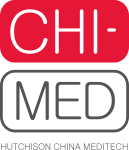Chi-Med Initiates a Phase II Trial of HMPL-453 in Patients with Advanced Intrahepatic Cholangiocarcinoma in China
HONG KONG and SHANGHAI, China and FLORHAM PARK, N.J., Sept. 03, 2020 (GLOBE NEWSWIRE) -- Hutchison China MediTech Limited (“Chi-Med”) (Nasdaq/AIM: HCM) has initiated a Phase II study of HMPL-453, its novel small molecule inhibitor targeting fibroblast growth factor receptors (“FGFR”), in patients with advanced intrahepatic cholangiocarcinoma (“IHCC”), which is a type of liver cancer.
The clinical study is a single-arm, multi-center, open-label study, evaluating the efficacy, safety and pharmacokinetics of HMPL-453 in patients with advanced IHCC with FGFR2 fusion that had failed at least one line of systemic therapy.
The primary outcome measure is objective response rate (ORR). Secondary outcome evaluations include preliminary efficacy measures, such as disease control rate (DCR), time to response (TTR), duration of response (DoR), progression-free survival (PFS), and overall survival (OS). Additional details may be found at clinicaltrials.gov, using identifier NCT04353375.
About IHCC
IHCC is a cancer that develops in the cells within the bile ducts1. With over 390,000 new cases every year, China accounted almost 50% of the world’s annual incidence of liver cancer in 2018.2,3 After hepatocellular carcinoma (“HCC”), IHCC is the second most common primary hepatic malignancy accounting for 10% to 20% of newly diagnosed liver cancers4. Approximately 10-15% of IHCC patients have tumors that harbor FGFR2 fusion5,6. Long-term survival for patients with IHCC is worse than for HCC, which may be related to a high propensity for regional and distant metastases as well as the lack of effective systemic therapy options2.
About FGFR
FGFRs are a sub‑family of receptor tyrosine kinases. Activation of FGFR signaling pathways is central to several biological processes. In normal physiology, FGF/FGFR signaling is involved in embryonic development (organogenesis and morphogenesis), tissue repair, angiogenesis, neuroendocrine and metabolism homeostasis. Given its complexity and critical role in a number of important physiological processes, aberrant FGFR signaling has been found to be a driving force in tumor growth, promotion of angiogenesis, as well as conferring resistance to anti‑tumor therapies.
About HMPL‑453
HMPL‑453 is a novel, highly selective and potent small molecule inhibitor targeting FGFR 1, 2 and 3. In pre‑clinical studies, HMPL‑453 demonstrated superior potency and better kinase selectivity as compared to other drugs in the same class, as well as a favorable safety profile. Enrollment has been completed for the dose escalation of the Phase I study of HMPL-453 in China (clinicaltrials.gov identifier NCT03160833). Enrollment of a Phase II study is ongoing in patients with advanced malignant mesothelioma in China (clinicaltrials.gov identifier NCT04290325).
About Chi-Med
Chi-Med (Nasdaq/AIM: HCM) is an innovative, commercial-stage, biopharmaceutical company committed, over the past twenty years, to the discovery and global development of targeted therapies and immunotherapies for the treatment of cancer and immunological diseases. It has a portfolio of nine cancer drug candidates currently in clinical studies around the world and extensive commercial infrastructure in its home market of China. For more information, please visit: www.chi-med.com.
Forward-Looking Statements
This press release contains forward-looking statements within the meaning of the “safe harbor” provisions of the U.S. Private Securities Litigation Reform Act of 1995. These forward-looking statements reflect Chi-Med’s current expectations regarding future events, including its expectations for the clinical development of HMPL-453, including plans to initiate clinical studies for HMPL-453, its expectations as to whether such studies would meet their primary or secondary endpoints, and its expectations as to the timing of the completion and the release of results from such studies. Forward-looking statements involve risks and uncertainties. Such risks and uncertainties include, among other things, assumptions regarding enrollment rates, timing and availability of subjects meeting a study’s inclusion and exclusion criteria, changes to clinical protocols or regulatory requirements, unexpected adverse events or safety issues, the ability of drug candidate HMPL-453 to meet the primary or secondary endpoint of a study, to obtain regulatory approval in different jurisdictions, to gain commercial acceptance after obtaining regulatory approval, the potential market of HMPL-453 for a targeted indication and the sufficiency of funding. Existing and prospective investors are cautioned not to place undue reliance on these forward-looking statements, which speak only as of the date hereof. For further discussion of these and other risks, see Chi-Med’s filings with the U.S. Securities and Exchange Commission and on AIM. Chi-Med undertakes no obligation to update or revise the information contained in this press release, whether as a result of new information, future events or circumstances or otherwise.
CONTACTS
| Investor Enquiries | |
| Mark Lee, Senior Vice President | +852 2121 8200 |
| Annie Cheng, Vice President | +1 (973) 567 3786 |
| Media Enquiries | |
| Americas – Brad Miles, Solebury Trout | +1 (917) 570 7340 (Mobile) bmiles@troutgroup.com |
| Europe – Ben Atwell / Alex Shaw, FTI Consulting | +44 20 3727 1030 / +44 7771 913 902 (Mobile) / +44 7779 545 055 (Mobile) Chi-Med@fticonsulting.com |
| Asia – Joseph Chi Lo / Zhou Yi, Brunswick | +852 9850 5033 (Mobile), jlo@brunswickgroup.com / +852 9783 6894 (Mobile), yzhou@brunswickgroup.com |
| Nominated Advisor | |
| Freddy Crossley / Atholl Tweedie, Panmure Gordon (UK) Limited | +44 (20) 7886 2500 |
_________________________
1 NIH. Genetic & Rare Diseases Information Center. rarediseases.info.nih.gov/diseases/6042/intrahepatic-cholangiocarcinoma.
2 Global Cancer Observatory. China Fact Sheet. gco.iarc.fr/today/data/factsheets/populations/160-china-fact-sheets.pdf.
3 Global Cancer Observatory. Liver Cancer Fact Sheet. gco.iarc.fr/today/data/factsheets/cancers/11-Liver-fact-sheet.pdf.
4 Epidemiology of Hepatocellular Carcinoma and Intrahepatic Cholangiocarcinoma. Cancer Control. https://www.ncbi.nlm.nih.gov/pmc/articles/PMC5937247.
5 Lowery et al. Comprehensive Molecular Profiling of Intrahepatic and Extrahepatic Cholangiocarcinomas: Potential Targets for Intervention. Clin Cancer Res September 1 2018 (24) (17) 4154-4161. DOI: 10.1158/1078-0432.CCR-18-0078.
6 Cleary et al. Therapeutic targeting of extracellular FGFR2 activating deletions in intrahepatic cholangiocarcinoma. J Clin Oncol 38, 2020 (suppl 4; abstr 567). DOI: 10.1200/JCO.2020.38.4_suppl.567.

